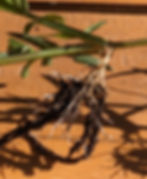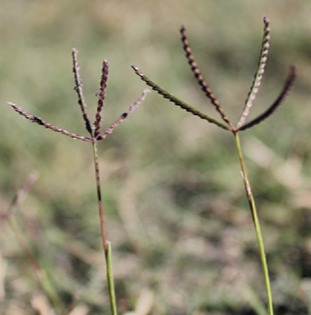No, That is Not a Weed: Exploring Bermuda Grass Seed Heads
- Seth Newell
- May 4, 2024
- 3 min read
Updated: Jul 4
At first glance, those little chicken-foot-like stalks poking up from your Bermuda lawn might look like weeds or signs of neglect. But take a closer look, and you’ll find something fascinating: Bermudagrass seed heads—nature’s own turfgrass signal flare. Far from being a nuisance, these structures tell a story about your lawn’s health, stress, and seasonal rhythm. Let’s break it down.
What Are Bermudagrass Seed Heads?
Bermudagrass (Cynodon dactylon) is a warm-season turfgrass admired for its aggressive growth and resilience—particularly in the transition zone of the southern U.S., including Oklahoma. During peak growing conditions, it forms seed heads that resemble a three-to-five-pronged "chicken foot" emerging from the leaf canopy.
These are reproductive structures, signaling that your turfgrass is in a mature growth stage. While they may not win beauty contests, they’re entirely natural and, in non-hybrid varieties, they can actually produce viable seed.
Seed Heads vs. Turf Health: The Real Indicator
Let’s clear this up: Bermuda lawns don't depend on seed heads for reproduction. Instead, the heavy lifting comes from stolons (above ground runners) and rhizomes (below ground runners). These aggressive spreaders are the real reason Bermuda fills in so well—even when mowed regularly.

Seed heads, on the other hand, can indicate stress—not success. If you're suddenly seeing lots of them, it's time to investigate. Common causes include:
Drought stress or shallow watering
Compacted soil
Poor fertility
High mowing height or skipped mowings
Excess heat or sudden environmental shifts
In short: when Bermuda throws out seed heads, it may be saying, “Help me out down here!”
Timing: When Do Seed Heads Appear?
Proper mowing is your frontline defense against excessive seed head development. Here’s the rule: never remove more than one-third of the blade in a single mowing session. Allowing your grass to grow too long between cuts leads to more stalky growth and more seed head production.
What happens if you don’t mow? You’ll get that hayfield look—and don’t expect a magic reseeding effect. Most seed produced by common Bermudagrass in home lawns is sterile, meaning those tips won’t fill in bare spots. Regular mowing also discourages thatchy build-up and maintains a uniform, lush appearance.
Fertility & Water: Keep the Roots Happy
Seed heads can be a cry for help from an undernourished or thirsty lawn. A well-fed Bermuda lawn, fertilized based on a soil test and maintained with deep, infrequent irrigation, is less likely to show excessive seed head production.
Fertilize with nitrogen-rich sources during peak growth (late spring through summer).
Irrigate deeply but infrequently to promote deep rooting.
Avoid overwatering or watering too late in the day to prevent disease pressure.
If you’re following our Premium7 or BermudaMAX plan, your turf is already getting these nutrients at optimal times of year.
Can I Control Seed Heads?
To minimize the visual impact:
Mow frequently during high seed head production periods.
Consider using growth regulators (with professional guidance) to suppress seed stalk formation and promote density.
Stay on top of cultural practices like aeration and dethatching to relieve soil compaction and improve uptake of water and nutrients.
Consider using Plant Growth Regulators (PGRs) under professional guidance. These specialized products suppress seed head development by targeting hormonal growth processes, allowing for a more uniform and polished appearance. At Newell Services, we prefer Anuew, a professional-grade PGR containing Prohexadione calcium (27.5%), for its excellent performance on common and hybrid Bermudagrass. It offers both seed head suppression and improved turf color, and is rainfast within hours of application.
The Takeaway
Seed heads in Bermuda grass are not weeds, and they’re not necessarily bad. But they’re also not the lush look most homeowners want. By understanding what they are and why they appear, you can make smarter lawn care decisions.
Keep your grass trimmed, your soil fed, and your irrigation dialed in—and let the seed heads serve as helpful signposts, not stress points.
If your lawn’s flashing seed heads like a distress signal and you’re not sure what to do next, we’re here to help. Whether it’s compaction relief, fertilization support, or professional mowing tips, we’ve got a plan for you.
📩 Reach out today through our Work Request Form and let's make your Bermuda lawn great again:
Let the neighbors worry about their weeds. You’ve got this. 🌱
—Newell Services, LLC | Make My Lawn Great!Licensed, Local, and Lawn-Obsessed in Northeast Oklahoma.





